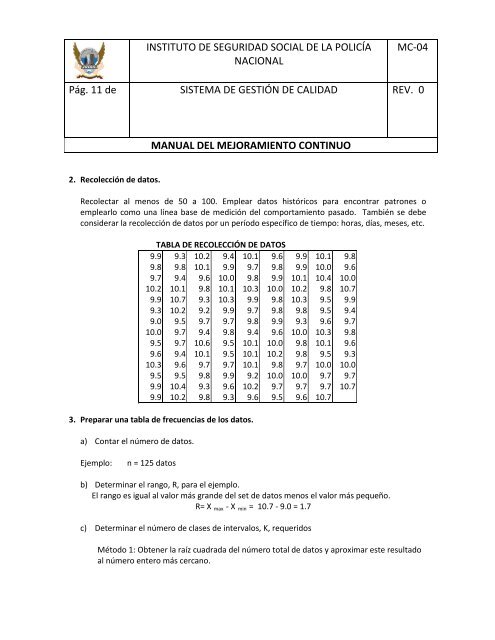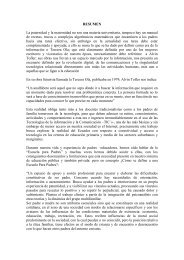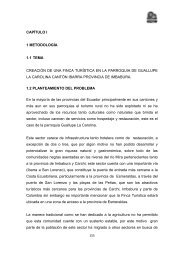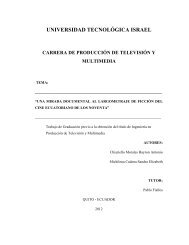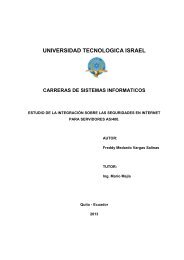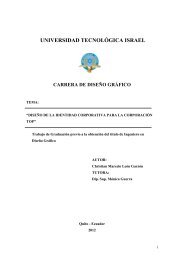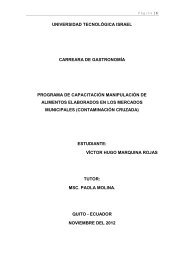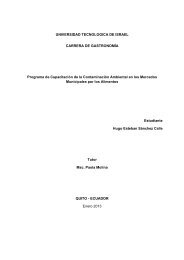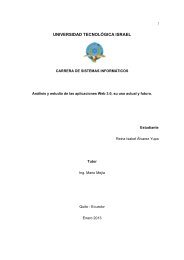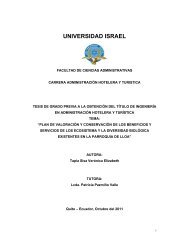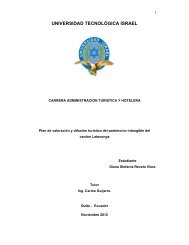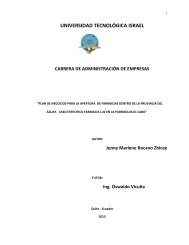- Page 1 and 2:
TEMA: UNIVERSIDAD TECNOLÓGICA ISRA
- Page 3 and 4:
UNIVERSIDAD TECNOLÓGICA ISRAEL AUT
- Page 5 and 6:
DEDICATORIA A mi señor, Jesús qui
- Page 7 and 8:
A.- PRELIMINARES ÍNDICE GENERAL Po
- Page 9 and 10:
C.- MATERIALES DE REFERENCIA GLOSAR
- Page 11 and 12:
ÍNDICE DE GRÁFICOS 1. Gráfico No
- Page 13 and 14:
TOPIC: UNIVERSIDAD TECNOLÓGICA ISR
- Page 15 and 16:
Prestaciones del Instituto de Segur
- Page 17 and 18:
de extraordinaria calidad. Esta Ges
- Page 19 and 20:
CONTEXTUALIZACIÓN MACRO CONTEXTO A
- Page 21 and 22:
DELIMITACIÓN DEL OBJETO DE INVESTI
- Page 23 and 24:
JUSTIFICACIÓN PRÁCTICA La estruct
- Page 25 and 26:
CAPÍTULO II MARCO TEÓRICO Y METOD
- Page 27 and 28:
cadena de valor que se relacionen d
- Page 29 and 30:
de la utilización eficiente de los
- Page 31 and 32:
FUNDAMENTACION LEGAL La fundamentac
- Page 33 and 34:
La norma ISO 9001:2008 elaborada po
- Page 35 and 36:
CUADRO N° 2 NUMERO DE POLICIAS A N
- Page 37 and 38:
Elaborado: Kleber Enriquez. Fuente:
- Page 39 and 40:
CAPITULO III RESULTADOS La encuesta
- Page 41 and 42:
1B - ¿Ha hecho uso de los servicio
- Page 43 and 44:
Elaborado: Kleber Enriquez. Fuente:
- Page 45 and 46:
Siendo los préstamos los productos
- Page 47 and 48:
Elaborado: Kleber Enriquez. Fuente:
- Page 49 and 50:
Elaborado: Kleber Enriquez. Fuente:
- Page 51 and 52:
adican básicamente en las garantí
- Page 53 and 54:
Elaborado: Kleber Enriquez. Fuente:
- Page 55 and 56:
eneficiaron de un préstamo quirogr
- Page 57 and 58:
Elaborado: Kleber Enriquez. Fuente:
- Page 59 and 60:
Elaborado: Kleber Enriquez. Fuente:
- Page 61 and 62:
CAPITULO IV CONCLUSIONES Y RECOMEND
- Page 63 and 64:
RECOMENDACIONES TITULO DE LA PROPUE
- Page 65 and 66:
Al ser imposible unificar los benef
- Page 67 and 68:
JUSTIFICACIÓN DE LA PROPUESTA Sien
- Page 69 and 70:
ANÁLISIS DE FACTIBILIDAD DE IMPLEM
- Page 71 and 72:
Elaborado: Kleber Enriquez. Fuente:
- Page 73 and 74:
Gestión de Recursos. 6.1 Provisió
- Page 75 and 76:
OBSERVACIONES: - EL INSTITUTO DE SE
- Page 77 and 78:
4.2.3. Control de la documentación
- Page 79 and 80:
OBSERVACIÓN: - Se evidenció el co
- Page 81 and 82:
LA NORMA ISO 9001:2008 ESTABLECE: 5
- Page 83 and 84:
- No se evidenció documentadamente
- Page 85 and 86:
LA NORMA ISO 9001:2008 ESTABLECE: 5
- Page 87 and 88:
OBSERVACIÓN: - Debido a que el pro
- Page 89 and 90:
- No se evidenció que se mantengan
- Page 91 and 92:
Recomendaciones: - Identificar, pro
- Page 93 and 94:
) Requisitos no especificados por e
- Page 95 and 96:
Recomendación: - Formalizar los pr
- Page 97 and 98:
Los datos finales del diseño y/o d
- Page 99 and 100:
a la implantación o entrega, se de
- Page 101 and 102:
) Requisitos del sistema de gestió
- Page 103 and 104:
OBSERVACIONES: - Existe informació
- Page 105 and 106:
LA NORMA ISO 9001:2008 ESTABLECE: 7
- Page 107 and 108:
LA NORMA ISO 9001:2008 ESTABLECE: 7
- Page 109 and 110:
- No se evidenció, documentadament
- Page 111 and 112:
equisitos del cliente. Estos métod
- Page 113 and 114:
Recomendación: - Formalizar, docum
- Page 115 and 116:
d) Determinar e implementar la acci
- Page 117 and 118:
El Modelo Operativo para la ejecuci
- Page 119 and 120:
ecomendaciones de la Comandancia Ge
- Page 121 and 122:
SECCIÓN 4. SISTEMA DE GESTIÓN DE
- Page 123 and 124:
PROCESOS. ESTRATÉGICOS PROCESOS QU
- Page 125 and 126:
4.2.3 Control de los documentos Par
- Page 127 and 128:
Esta política es revisada periódi
- Page 129 and 130:
a. Asegurar que los procesos del Si
- Page 131 and 132:
SECCIÓN 6 GESTIÓN DE RECURSOS 6.1
- Page 133 and 134:
SECCIÓN 7. REALIZACION DEL SERVICI
- Page 135 and 136:
las especificaciones de los bienes
- Page 137 and 138:
7.5.4 Propiedad del usuario (client
- Page 139 and 140:
8.2.3 Seguimiento y medición de lo
- Page 141 and 142:
PERSPECTIVA Y/O EVALUACIÓN DE IMPA
- Page 143 and 144:
SISTEMA DE GESTIÓN DE LA CALIDAD E
- Page 145 and 146:
SUBPROCESO: Es la mínima agrupaci
- Page 147 and 148:
BIBLIOGRAFÍA. HERRERA Luis, MEDINA
- Page 149 and 150:
INSTITUTO DE SEGURIDAD SOCIAL DE LA
- Page 151 and 152:
INSTITUTO DE SEGURIDAD SOCIAL DE LA
- Page 153 and 154:
1. PROCESOS ESTRATÉGICOS: INVENTAR
- Page 155 and 156:
4.1 GESTIÓN DE TECNOLOGÍAS INFORM
- Page 157 and 158:
INSTITUTO DE SEGURIDAD SOCIAL DE LA
- Page 159 and 160:
INSTITUTO DE SEGURIDAD SOCIAL DE LA
- Page 161 and 162:
INSTITUTO DE SEGURIDAD SOCIAL DE LA
- Page 163 and 164: PROCESO: GESTIÓN DE PRESTACIONES S
- Page 165 and 166: INSTITUTO DE SEGURIDAD SOCIAL DE LA
- Page 167 and 168: INSTITUTO DE SEGURIDAD SOCIAL DE LA
- Page 169 and 170: 29 30 31 32 33 34 ELABORO STORICO D
- Page 171 and 172: 24 25 26 27 28 29 #¡REF! #¡REF! #
- Page 173 and 174: 26 27 • Emitir Orden de Pago al J
- Page 175 and 176: 25 • Revisar la disposición del
- Page 177 and 178: 26 27 28 • Disponer al Jefe de In
- Page 179 and 180: 26 • Revisar la disposición del
- Page 181 and 182: 1. Nombre del Proceso Gestión de C
- Page 183 and 184: 1. Nombre del Proceso Gestión de P
- Page 185 and 186: INSTITUTO DE SEGURIDAD SOCIAL DE LA
- Page 187 and 188: INSTITUTO DE SEGURIDAD SOCIAL DE LA
- Page 189 and 190: INSTITUTO DE SEGURIDAD SOCIAL DE LA
- Page 191 and 192: INSTITUTO DE SEGURIDAD SOCIAL DE LA
- Page 193 and 194: INSTITUTO DE SEGURIDAD SOCIAL DE LA
- Page 195 and 196: INSTITUTO DE SEGURIDAD SOCIAL DE LA
- Page 197 and 198: INSTITUTO DE SEGURIDAD SOCIAL DE LA
- Page 199 and 200: INSTITUTO DE SEGURIDAD SOCIAL DE LA
- Page 201 and 202: INSTITUTO DE SEGURIDAD SOCIAL DE LA
- Page 203 and 204: INSTITUTO DE SEGURIDAD SOCIAL DE LA
- Page 205 and 206: INSTITUTO DE SEGURIDAD SOCIAL DE LA
- Page 207 and 208: INSTITUTO DE SEGURIDAD SOCIAL DE LA
- Page 209 and 210: INSTITUTO DE SEGURIDAD SOCIAL DE LA
- Page 211 and 212: INSTITUTO DE SEGURIDAD SOCIAL DE LA
- Page 213: INSTITUTO DE SEGURIDAD SOCIAL DE LA
- Page 217 and 218: Pág. 13 de INSTITUTO DE SEGURIDAD
- Page 219 and 220: Pág. 15 de INSTITUTO DE SEGURIDAD
- Page 221 and 222: Pág. 17 de INSTITUTO DE SEGURIDAD
- Page 223 and 224: Pág. 19 de INSTITUTO DE SEGURIDAD
- Page 225 and 226: Pág. 21 de 1. Definir el marco del
- Page 227 and 228: Pág. 23 de INSTITUTO DE SEGURIDAD
- Page 229 and 230: Pág. 25 de INSTITUTO DE SEGURIDAD
- Page 231 and 232: INSTITUTO DE SEGURIDAD SOCIAL DE LA
- Page 233 and 234: INSTITUTO DE SEGURIDAD SOCIAL DE LA
- Page 235 and 236: INSTITUTO DE SEGURIDAD SOCIAL DE LA
- Page 237 and 238: INSTITUTO DE SEGURIDAD SOCIAL DE LA
- Page 239 and 240: INSTITUTO DE SEGURIDAD SOCIAL DE LA
- Page 241 and 242: INSTITUTO DE SEGURIDAD SOCIAL DE LA
- Page 243 and 244: INSTITUTO DE SEGURIDAD SOCIAL DE LA
- Page 245 and 246: INSTITUTO DE SEGURIDAD SOCIAL DE LA
- Page 247 and 248: INSTITUTO DE SEGURIDAD SOCIAL DE LA
- Page 249 and 250: INSTITUTO DE SEGURIDAD SOCIAL DE LA
- Page 251 and 252: INSTITUTO DE SEGURIDAD SOCIAL DE LA
- Page 253 and 254: INSTITUTO DE SEGURIDAD SOCIAL DE LA
- Page 255 and 256: INSTITUTO DE SEGURIDAD SOCIAL DE LA
- Page 257 and 258: INSTITUTO DE SEGURIDAD SOCIAL DE LA
- Page 259 and 260: INSTITUTO DE SEGURIDAD SOCIAL DE LA
- Page 261 and 262: INSTITUTO DE SEGURIDAD SOCIAL DE LA
- Page 263 and 264: INSTITUTO DE SEGURIDAD SOCIAL DE LA
- Page 265 and 266:
INSTITUTO DE SEGURIDAD SOCIAL DE LA
- Page 267 and 268:
INSTITUTO DE SEGURIDAD SOCIAL DE LA
- Page 269 and 270:
INSTITUTO DE SEGURIDAD SOCIAL DE LA
- Page 271 and 272:
INSTITUTO DE SEGURIDAD SOCIAL DE LA
- Page 273 and 274:
INSTITUTO DE SEGURIDAD SOCIAL DE LA
- Page 275 and 276:
INSTITUTO DE SEGURIDAD SOCIAL DE LA
- Page 277 and 278:
INSTITUTO DE SEGURIDAD SOCIAL DE LA
- Page 279 and 280:
INSTITUTO DE SEGURIDAD SOCIAL DE LA
- Page 281 and 282:
INSTITUTO DE SEGURIDAD SOCIAL DE LA
- Page 283 and 284:
INSTITUTO DE SEGURIDAD SOCIAL DE LA
- Page 285 and 286:
INSTITUTO DE SEGURIDAD SOCIAL DE LA
- Page 287 and 288:
INSTITUTO DE SEGURIDAD SOCIAL DE LA
- Page 289 and 290:
INSTITUTO DE SEGURIDAD SOCIAL DE LA
- Page 291 and 292:
INSTITUTO DE SEGURIDAD SOCIAL DE LA
- Page 293 and 294:
INSTITUTO DE SEGURIDAD SOCIAL DE LA
- Page 295 and 296:
INSTITUTO DE SEGURIDAD SOCIAL DE LA
- Page 297 and 298:
INSTITUTO DE SEGURIDAD SOCIAL DE LA
- Page 299 and 300:
INSTITUTO DE SEGURIDAD SOCIAL DE LA
- Page 301 and 302:
INSTITUTO DE SEGURIDAD SOCIAL DE LA
- Page 303 and 304:
INSTITUTO DE SEGURIDAD SOCIAL DE LA
- Page 305 and 306:
INSTITUTO DE SEGURIDAD SOCIAL DE LA
- Page 307 and 308:
INSTITUTO DE SEGURIDAD SOCIAL DE LA
- Page 309 and 310:
INSTITUTO DE SEGURIDAD SOCIAL DE LA
- Page 311 and 312:
INSTITUTO DE SEGURIDAD SOCIAL DE LA
- Page 313 and 314:
Quito,___ de ________ del _______ O
- Page 315 and 316:
Quito, ______________ del 201 Seño
- Page 317 and 318:
Autorización de Débito para el En
- Page 319 and 320:
INSTITUTO DE SEGURIDAD SOCIAL DE LA
- Page 321 and 322:
I.S.S.P.O.L INSTITUTO DE SEGURIDAD
- Page 323:
CONCLUSIONES: Una vez revisada y an


